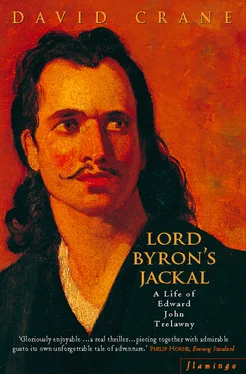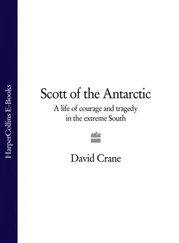And yet Byron, if he ever had been, was no longer the ‘Childe’ and in that simple truth lay a world of future misunderstandings. One of the most moving aspects of his last year is the way his letters and actions reveal a gradual firming of purpose, a steady discarding of the conceits and fripperies of his Italian existence, a unifying of personality, an alignment at last of intelligence and sensibility – a growth into a human greatness which mirrors the development of his literary talents from the emotional and psychological crudity of ‘Childe Harold’ into the mature genius of ‘Don Juan’.
For anyone interested in poetry it is in that last masterpiece that the real Byron is to be found, but it was not the Byron that Trelawny had come to Italy in search of. Even before the Hercules had left Leghorn he was airing his reservations in letters to Roberts and Claire, but the fact is that his unease in Byron’s company was as long as their friendship itself. Eighteen months earlier, in January 1822, Trelawny had come looking for Childe Harold and found instead a middle-aged and worldly realist. He had come to worship and found a deity cynically sceptical of his own cult. ‘I had come prepared to see a solemn mystery,’ he wrote of their first meeting in the Palazzo Lanfranchi, ‘and so far as I could judge from the first act it seemed to me very like a solemn farce.’ 45
One of the great truisms of Romantic history is that Byron was never ‘Byronic’ enough for his admirers but this failure to live up to expectations seems to have constituted a more personal betrayal for Trelawny than it did for other acolytes. In trying to explain this there is a danger of ignoring the vast intellectual gap which separated the two men, yet nevertheless something is needed to account for the resentment which, even as they set off together, he was stoking up against Byron. Partly, of course, it was the bitterness of the disappointed disciple, but there was something more than that, something which Romantic myth and twentieth-century psychology in their different ways both demand to be recognized – the rage of the creature scorned in the language of one, of childhood rejection in the more prosaic terminology of the other.
The moment words are put to it they seem overblown and lame by turns but it is impossible to ignore the evidence of a lifetime’s anger. No iconoclast ever had such a capacity for hero-worship as Trelawny and, of the long string of real or imagined figures who filled the emotional vacuum of a loveless childhood, Byron was the earliest and the greatest. In among the fantasies that Trelawny published as his Adventures , there is a description of his first meeting with the mythical De Ruyter, the imagined archetype and amalgam of all Trelawny’s heroes. It gives a vivid insight into what he had sought in Byron when he first came to Italy. ‘He became my model,’ he wrote,
The height of my ambition was to imitate him, even in his defects. My emulation was awakened. For the first time I was impressed with the superiority of a human being. To keep an equality with him was unattainable. In every trifling action he evinced a manner so offhand, free, and noble, that it looked as if it sprung new and fresh from his own individuality; and everything else shrunk into an apish imitation. 46
This kind of hero, however, was not a role that the thirty-five-year old Byron, with his anxieties over his weight or the thickness of his wrists, had either the inclination or temperament to fill. The helmets and uniforms in his luggage are reminders that, even in his last year, the exhibitionist in him was never entirely stilled, but the irony and self-mockery with which he treated himself in his poetry was now equally, if humorously, turned on his ‘corsair’. Trelawny, he memorably remarked, could not tell the truth even to save himself. In another variant on this he suggested that they might yet make a gentleman of him if they could only get him to tell the truth and wash his hands.
For a man who was probably only too familiar with Trelawny’s battle against his father’s pet raven, this was a dangerously cavalier attitude to take to the child of his poetic imagination. ‘The Creator’, as Claire had warned Byron in her first letter to him before they met, ‘ought not to destroy his Creature.’ 47 For a man, also, who in Pisan lore had been responsible for the death of Claire’s Allegra, this was doubly true. Byron was too careless, however, to see the trouble he was laying down. On board the Hercules a mixture of his own tolerance and Trelawny’s presumption kept relationships cordial, but it was a deceptive calm. ‘Lord B. and myself are extraordinarily thick,’ Trelawny wrote edgily to his friend Roberts in a letter from Leghorn.
We are inseparable. But mind, this does not flatter me. He has known me long enough to know the sacrifices I make in devoting myself to serve him. This is new to him, who is surrounded by mercenaries. I am no expense to him, fight my own way, lay in my own stock, etc … Lord B. indeed does everything as far as I wish him.’ 48
It was a sad delusion but it was enough to preserve the peace of the voyage. At the toe of Italy the Hercules turned east, through the Messina Straits and towards Greece. Their first destination was the port of Argostoli on Cephalonia, one of the Ionian Isles under British control. As they passed through the untroubled waters between Scylla and Charybdis, Byron complained of the tameness of life. His boredom was premature. His and Trelawny’s lives were moving to their distinct but inseparable crises. ‘Where’, Byron had mused at Leghorn, ‘shall we be in a year?’ It afterwards seemed to Pietro Gamba, Teresa Guiccoli’s brother, ‘a melancholy foreboding; for on the same day of the same month, in the next year, he was carried to the tomb of his ancestors.’ 49 On 2 August 1823, the Hercules entered the approaches to Argostoli. Byron had just nine months to live: Trelawny, nearly sixty years to vent his feelings against the man who had first created and then wearied of him.
‘And without ties – wearied and wretched – melancholy and dissatisfied – what was left me here? – I have been dying piecemeal – thin – careworn – and desponding – Such an excitement as this was necessary to rouse me into energy and life – and it has done so – I am all on fire for action – and ready to endure the worst that may befall, seeking nothing but honour.’
Trelawny to Claire Clairmont 22 July 1823 1
TEN DAYS AFTER THE Hercules anchored off the port of Argostoli, a small group from the ship lay picnicking beside the Fountain of Arethusa on the Homeric isle of Ithaca. Beneath them the water from the spring tumbled away into a dark ravine. ‘The view,’ Hamilton Browne, the young Philhellene who had joined them at Leghorn, recalled ten years later,
embracing the vast sea-prospect, the Aechirades, the entrance to the Gulf of Corinth, or Lepanto, with the distant purple mountains of Epirus and Aetolia, lifting their lofty peaks into the clouds, was superb; and ascending the hill at the back of the cavern, Santa Maura, the ancient Leucadia, with its dependencies, was distinctly descried, together with Cephalonia, apparently close at hand; Zante, and the coast of the Peloponessus, trending far away to the southeast. A more lovely situation could scarcely be imagined. 2
It would be difficult also to imagine a view more completely at odds with reality. If one could have followed Browne’s panoramic sweep across the map of western and southern Greece, only seen it shorn of that seductive allure which distance and classical associations gave it for him – if one could have extended that view further, beyond the ruined city of Tripolis to Nauplia and Argos in the east, and beyond those again as far northwards as Salonica or south to Crete and Cyprus: or, again, if one shortened that perspective, to take in the emaciated figures crowding the little port of Vathi hidden at the picnickers’ feet, refugees from the ruins of Patras and the horrors of Chios, then wherever one looked the wasted faces of survivors or the whitening bones which littered the Greek landscape in their thousands would all have told the same story of a war of unimaginable brutality.
Читать дальше












